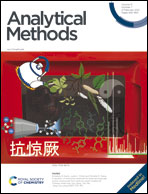Development of an electrochemical sensor for the determination of antibiotic sulfamethazine in cow milk using graphene oxide decorated with Cu–Ag core–shell nanoparticles†
Abstract
Determination and sensing of antibiotics in dairy products are the biggest challenges in the world. In continuation of our earlier study, a facile and novel determination method for the detection of sulfamethazine (SMZ) in cow milk has been developed using a glassy carbon electrode modified with graphene oxide decorated with Cu–Ag core–shell nanoparticles. The Cu–Ag core–shell nanoparticles and graphene oxide were synthesized and characterized via different techniques such as TEM, SEM, XRD and FTIR. The as-synthesized Cu–Ag core–shell nanoparticles were used for the decoration of the glassy carbon electrode modified with graphene oxide. The electroanalytical measurements including cyclic voltammetry and square wave voltammetry were performed and compared with HPLC, which was utilized for the determination of SMZ in cow milk. The experimental conditions were optimized to obtain a well-defined response signal. The concentration linear range was 10–1000 μM and the limit of detection was 0.46 μM for S/N = 3. The obtained results show good agreement with HPLC reported data.



 Please wait while we load your content...
Please wait while we load your content...